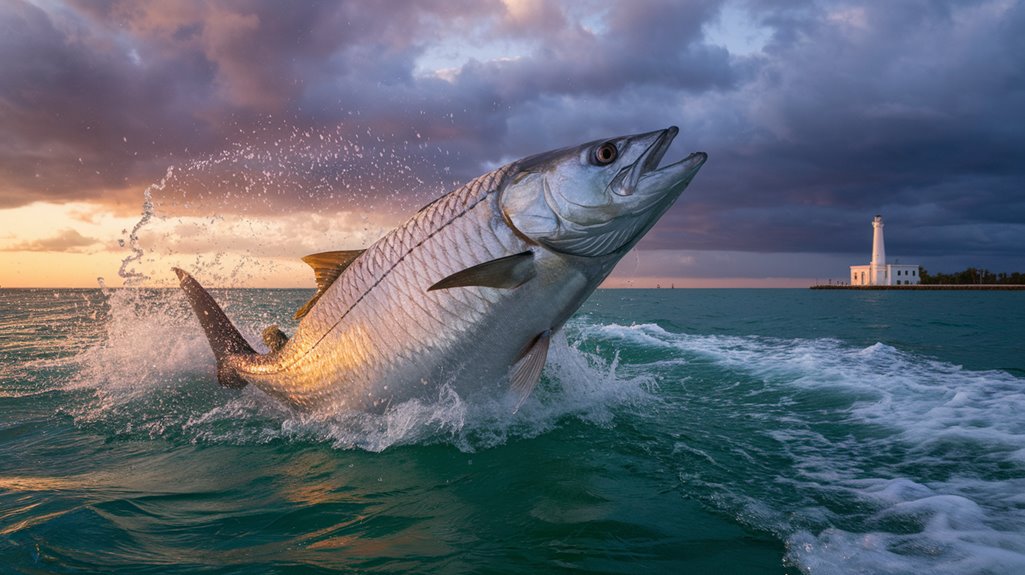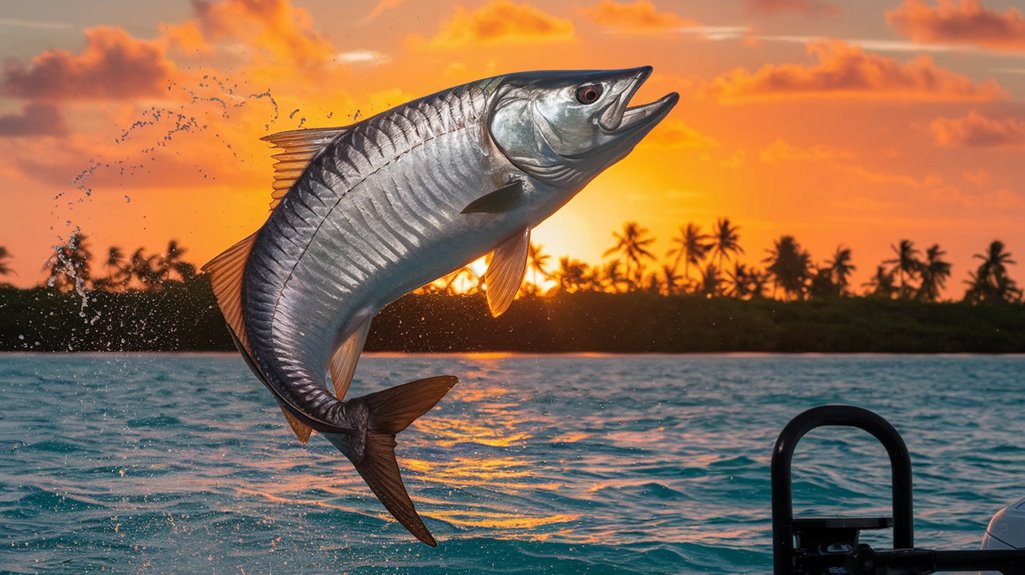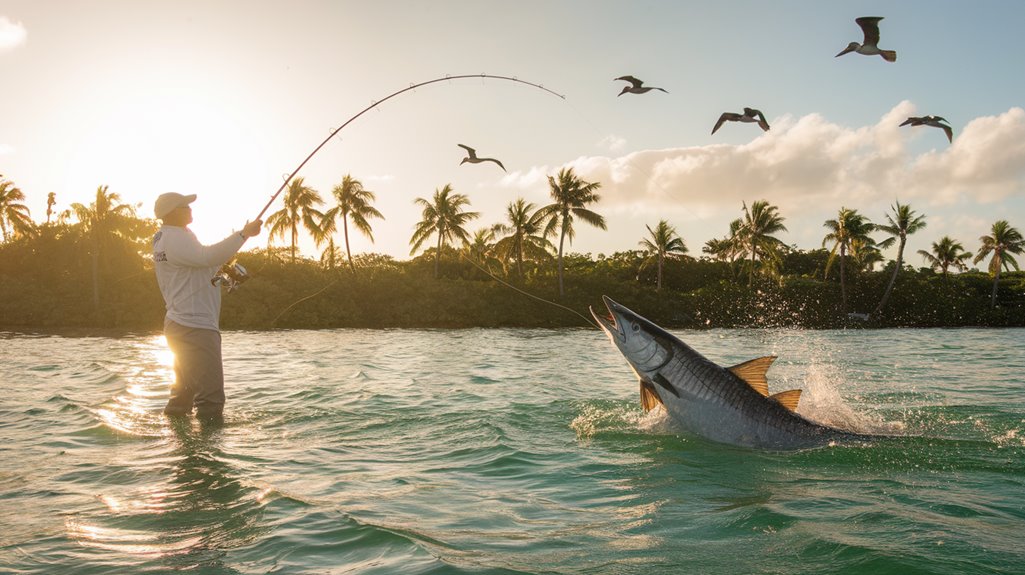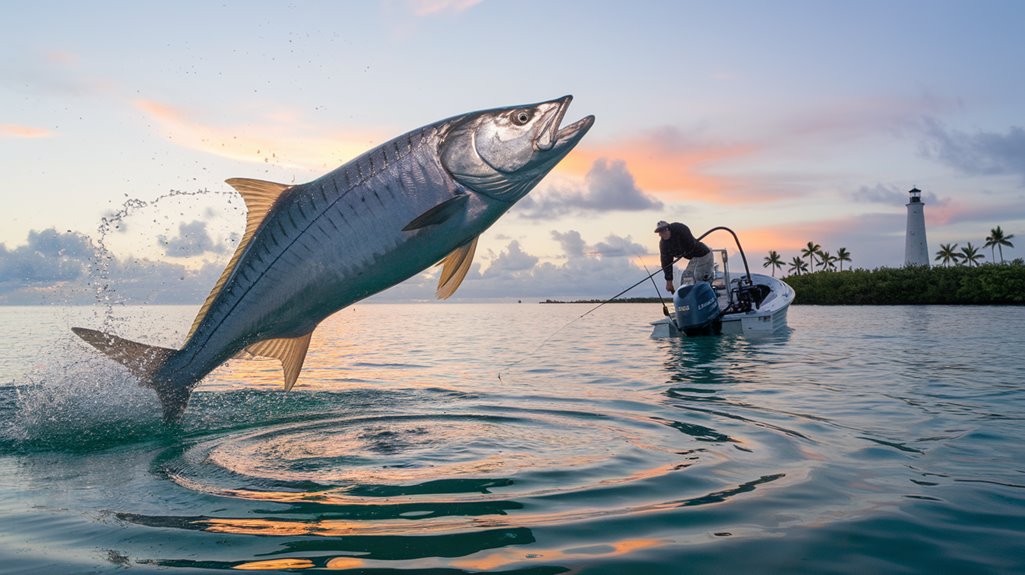You'll find no greater challenge in Florida's sport fishing than landing a Boca Grande tarpon during peak season. These magnificent "Silver Kings" can reach weights over 200 pounds and display aerial acrobatics that'll test your skills and equipment to their limits. As you prepare to target these prehistoric gamefish in the world's tarpon fishing capital, you'll need to understand the precise techniques, timing, and locations that separate success from frustration in these legendary waters.
Key Takeaways
- Boca Grande Pass hosts massive tarpon weighing 90-130 pounds during peak migration from May to July, attracting thousands of anglers annually.
- Focus fishing efforts during hill tides two days before and after full and new moons when tarpon are most active.
- Use heavy-duty gear with 30-pound test line and strong leaders (60-80 pounds) to handle powerful tarpon runs.
- Target early morning and late afternoon periods, especially during incoming tides, when tarpon are most likely feeding.
- Practice catch-and-release techniques and keep tarpon in water during handling to ensure their survival and conservation.
The Silver Kings of Boca Grande

Giants of the coastal waters, tarpon command respect as they patrol the legendary depths of Boca Grande Pass, where specimens regularly tip the scales between 90 to 130 pounds. Some exceptional Silver Kings even surpass 200 pounds, making Boca Grande worthy of its title as the Tarpon Capital of the World.
You'll find these majestic fish during their peak migration from May to July, when they're drawn to the Pass's deep waters and strong currents. As an angler, you're looking at approximately 5,000 tarpon landed each spring, but remember that Florida's fishing regulations mandate catch-and-release practices. You're only permitted to keep one tarpon with a purchased tag for record-keeping. The Pass's unique combination of shelter and abundant food sources, particularly crabs, creates the perfect environment for these impressive gamefish.
Essential Techniques and Tactics
You'll master live bait presentation by carefully matching your bait selection to the prevailing conditions, with pinfish and mullet proving especially effective during hill tides. Understanding Tarpon feeding patterns requires close attention to tidal movements and crab migrations through Boca Grande Pass, particularly during the peak season from late April through July. Your success rate will increase markedly when you combine precise bait presentation with strategic positioning during hill tides, when thousands of crabs create prime feeding opportunities.
Mastering Live Bait Presentation
Successfully presenting live bait to Boca Grande's tarpon requires mastering several essential techniques that can greatly impact your success rate. You'll need to hook your bait properly through the lips or back to maintain a natural presentation while positioning your boat upwind. The current plays a vital role, so let it work in your favor as you drift your offerings. Don't forget to use a strong leader between 60-80 pounds to handle those powerful runs.
- Monitor water temperature to identify peak feeding times during early morning and late afternoon
- Position yourself upwind and work with the current for ideal bait drift
- Hook pinfish, mullet, or pilchards through the lips or back for natural swimming motion
- Maintain stealth to avoid spooking nearby tarpon
- Switch to crabs during hill tides when they're flushing through Boca Grande Pass
Reading Tarpon Feeding Patterns
Understanding tarpon feeding patterns in Boca Grande requires careful observation of both environmental cues and fish behavior. You'll find tarpon most active during early morning and late afternoon hours, particularly during incoming tides when they're aggressively feeding on small fish and crustaceans.
Watch for water surface activity, including rolling or jumping, as these signs indicate prime feeding zones. During the April-to-October migration period, you'll notice large schools forming, offering excellent targeting opportunities. Focus on areas where live baits like pinfish, mullet, and crabs are abundant, especially during hill tides. For fly fishing enthusiasts, high-contrast flies work exceptionally well in clear waters when tarpon are in a feeding frenzy. By aligning your fishing strategy with these natural feeding patterns, you'll greatly improve your chances of success.
Prime Fishing Locations

You'll find Boca Grande Pass's most productive spots where migrating tarpon congregate in deep channels from March through November, with the strongest action near Gasparilla Island's nutrient-rich waters. Charlotte Harbor's expansive estuary system offers prime spring fishing opportunities, particularly in the weeks leading up to the July spawn. For a more secluded experience, you can target The Lighthouse Hole's deep-water areas, where tarpon gather in less pressured conditions close to shore.
Boca Grande Pass Hotspots
When targeting Tarpon in Boca Grande, several prime fishing locations stand out as proven hotspots for landing these magnificent gamefish. You'll find the deepest concentrations of Silver Kings in Boca Grande Pass from March through November, where the migratory fish species gather by the thousands. Charlotte Harbor's vast estuary system provides excellent fishing opportunities during spring's pre-spawn feeding frenzy.
- Boca Grande Pass – Deep waters teeming with Tarpon, peak season March-November
- Gasparilla Island – Prime location for viewing spectacular aerial displays
- Lighthouse Hole – Less pressured deep-water spot close to shore
- Charlotte Harbor – Extensive estuary system, excellent spring fishing
- Phosphate Dock/Turtle and Bull Bay – Diverse fishing opportunities with mixed species
Charlotte Harbor Fishing Grounds
The sprawling expanse of Charlotte Harbor presents anglers with diverse fishing grounds that rank among Florida's most productive tarpon habitats. You'll find exceptional opportunities at Boca Grande Pass and The Lighthouse Hole, where deep waters harbor large schools during the migration peak from May to July. These prime locations offer consistent action thanks to the harbor's rich food sources, including shrimp, blue crab, and perch.
As Florida's second-largest estuary, Charlotte Harbor's marine ecosystem supports not only tarpon but also snook and redfish throughout the summer months. You can target these diverse species until late fall when cooler temperatures arrive. The harbor's extensive network of fishing grounds provides reliable access to feeding tarpon, particularly in areas where prey concentrates and tidal movements create ideal hunting conditions.
Lighthouse Area Sweet Spots
Among Charlotte Harbor's prime fishing locations, Lighthouse Area's sweet spots stand out for their exceptional tarpon-holding structure. You'll find the Lighthouse Hole plunging to 70 feet, creating an ideal fishing environment for targeting multiple species. During peak fishing seasons, you'll benefit from the area's unique positioning near both deep and shallow waters, allowing you to switch tactics between bottom fishing and sight casting.
- Lighthouse Hole's 70-foot depth attracts abundant marine life, including tarpon, snapper, and grouper
- Hill tides trigger crab-driven feeding frenzies, maximizing your catch potential
- Strategic location near Boca Grande Lighthouse offers diverse habitat access
- Less crowded waters provide serene conditions for focused angling
- Versatile fishing grounds support multiple techniques and target species
Best Times and Seasons

Planning your Boca Grande tarpon fishing trip requires strategic timing to maximize success. You'll find the season kicks off in April when resident tarpon return to Charlotte Harbor, but the peak months run from May through July as massive schools of migrating tarpon flood Boca Grande Pass.
To enhance your chances, target hill tides occurring two days before and after full and new moons, when crab movements trigger increased tarpon activity. While many anglers pack up after June, you can actually continue fishing through October if weather conditions permit. For a more tranquil fishing experience with less fishing pressure, consider planning your trip in early April. You'll have prime spots to yourself before the traditional peak season crowds arrive, allowing for a more focused pursuit.
Gear and Equipment Setup
Since successful tarpon fishing demands specialized equipment, you'll need a heavy-duty setup capable of handling these powerful gamefish. For ideal results in Boca Grande, select a 7-8 foot heavy-action rod paired with a reel that can hold at least 200 yards of 30-pound test line. If you're into fly fishing, opt for 11-12 weight rods with high-contrast flies and floating lines.
- Heavy-duty rod and reel combo (7-8 feet) with minimum 200 yards of 30-pound test line
- Medium-action rods with 10-20 pound test for snook and redfish
- Fly fishing setup: 11-12 weight rods with floating lines and high-contrast flies
- Essential gear: polarized sunglasses, sunscreen, hat, and lightweight clothing
- Local fishing charters provide gear, bait, lures, and required fishing licenses
Rules and Conservation Guidelines
To maintain Boca Grande's world-class tarpon fishery, Florida enforces strict catch-and-release regulations with only one exception: anglers may harvest a single tarpon annually with a $51.50 IGFA record tag. Charter captains aren't bound by this tag limit, allowing them to guide multiple record-seeking clients throughout the season.
You'll need to adhere to Florida Fish and Wildlife's three-line maximum rule during peak season (April-June) to prevent overfishing. When handling tarpon, you must keep them in the water as much as possible. If you're taking photos, support the fish horizontally to guarantee its survival after release. Stay current with regulations by checking the official Florida Fish and Wildlife website, as conservation guidelines may change to protect this valuable fishery.
Frequently Asked Questions
What Is the Best Month to Fish for Tarpon at Boca Grande?
You'll find May offers prime tarpon fishing in Boca Grande, as massive schools converge in the pass. The fish are actively feeding, and you'll encounter ideal conditions with hill tides and crab migrations.
What Is the Best Bait for Tarpon in Boca Grande?
You'll find fresh pass crabs are your top bait choice during hill tides, while live pinfish, mullet, and pilchards work exceptionally well year-round for targeting Boca Grande's tarpon.
What Month Is Best for Tarpon Fishing?
You'll find peak tarpon fishing in May through July, when thousands of migrating fish flood the area. The strongest action typically occurs during hill tides around full and new moons.
What Is the Best Rig for Tarpon Fishing?
You'll want a heavy-duty rod with 200+ yards of 30-pound test line, 60-80 pound fluorocarbon leader, and 5/0-8/0 circle hook. Add a float or weight depending on technique.
Conclusion
You'll find Boca Grande's tarpon fishing offers unmatched opportunities to land these magnificent gamefish. By following proper techniques, selecting ideal gear, and adhering to conservation guidelines, you're positioned for success during peak migration seasons. Remember to check local regulations, maintain proper catch-and-release practices, and consider booking experienced guides. With the right preparation, you'll master the art of pursuing the Silver Kings in Florida's premier tarpon destination.

